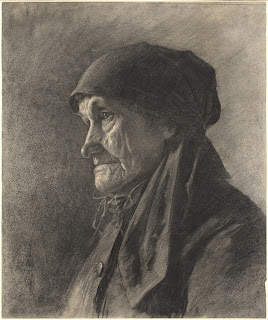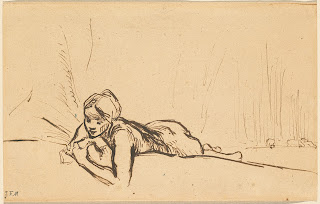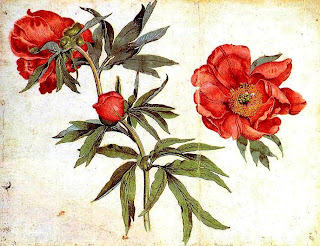Dürer, French Drawings and the Stages of Life
The National Gallery of Art is hosting the largest show of Albrecht Dürer drawings, prints and watercolors ever seen in North America, combining its own collection with that of the Albertina in Vienna, Austria. Across the street in the museum’s west wing is the another exhibition of works on paper, Color, Line and Light: French Drawings Watercolors and Pastels from Delacroix to Signac. The French drawings are spectacular, but it’s hard to imagine the 19th century masters without the earlier genius out of Germany, Dürer, who approached drawing with scientist’s curiosity for understanding nature.
 |
| Albrecht Dürer, Self-Portrait at Thirteen, 1484 silverpoint on prepared paper, 27.3 19.5 cm (10 3/4 7 11/16 in.) (framed): 51.7 43.1 4.5 cm (20 3/8 16 15/16 1 3/4 in.) Albertina, Vienna |
Dürer’s famous engravings are on view, including Adam and Eve, but with the added pleasure of seeing preparatory drawings and first trial proofs of the prints. Some of his most famous works such as the Great Piece of Turf and Praying Hands, are there also. In both exhibitions, as always, I’m drawn to the beauty and color of landscape art, especially prominent in the 19th century exhibition. However, both shows have phenomenal portraits to give us a glimpse into people of all ages with profound insights.
Dürer drew his own face while looking in the mirror at age 13, in 1484. He still had puffy cheeks and a baby face, but was certainly a prodigy. Like his father, he was trained in the goldsmith’s guild which gave him facility at describing the tiniest details with a very firm point. Seeing his picture next to the senior Dürer’s self-portrait, there’s no doubt his father was extremely gifted, too.
 |
| Albrecht Dürer, “Mein Agnes”, 1494 pen and black ink, 15.7 x 9.8 cm (6 1/8 x 3 7/8 in.) (framed): 44.3 x 37.9 x 4.2 cm (17 3/8 x 14 7/8 x 1 5/8 in.) Albertina, Vienna |
In his native Nuremburg, the younger Dürer was recognized at an early age and his reputation spread, particularly as the world of printing was spreading throughout the German territories, France and Italy. We can trace his development as he went to Italy in 1494-96, and then again in 1500, meeting with North Italian artists Andrea Mantegna and Giovanni Bellini and exchanging artistic ideas. Dürer is credited with bridging the gap between the Northern and Italian Renaissance. I personally find all his drawings and prints more satisfying then his oil paintings, because at heart he was first and foremost a draftsman.
Though we normally think of Dürer as a controlled draftsman, there are some very fresh, loose drawings. An image he did of his wife, Agnes, in 1494, shows a wonderful freedom of expression, and affection. He married Agnes Fry in 1494 and did drawings of her which became studies for later works. She was the model for St. Ann in a late painting of 1516 and the preparatory drawing with its amazing chiaroscuro is in the exhibition.
Also on view are Durer’s investigations into human proportion, landscapes and drawings he did of diverse subjects from which he later used in his iconic engravings. We can trace how the drawings inspired his visual imagery. There are also several preparatory drawings of old men who were used as the models for apostles in a painted altarpiece.
My favorite drawing of old age, however, is a study of an old man at age 93 who was alert and in good health (amazing as the life expectancy in 1500 was not what is today.) He appears very thoughtful, pensive and wise. The softness of his beard is incredible. The drawing is in silverpoint on blue gray paper which makes the figure appear very three-dimensional. To add force to the light and shadows, Durer added white to highlight, making the man so lifelike and realistic.
 |
| Léon Augustin Lhermitte, An Elderly Peasant Woman, c. 1878 charcoal, overall: 47.5 x 39.6 cm (18 11/16 x 15 9/16 in.) National Gallery of Art, Washington, Gift of Mr. and Mrs. James T. Dyke, 1996 |
In the other exhibition, there’s a comparable drawing by Leon Lhermitte of an old woman in Color, Line and Light. Lhermitte was French painter of the Realist school. He is not widely recognized today, but there were so many extraordinary artists in the mid-19th century. What I find especially moving about the painters of this time is more than their understanding of light and color. I like their approach to treating humble people, often the peasants, with extraordinary dignity. Lhermitte’s woman of age has lived a hard and rugged life and he crinkled skin signifies her amazing endurance. We see the beauty of her humanity and the artist’s reverence for every crevice in her weather-beaten skin.
 |
|
| Jean-François Millet Nude Reclining in a Landscape, 1844/1845 pen and brown ink, 16.5 x 25.6 cm (6 1/2 x 10 1/16 in.) Dyke Collection |
There are many portraits of youth in the French exhibition, too, including fresh pen and inks such as Edouard Manet’s Boy with a Dog and Francois Millet’s Nude Reclining in Landscape, who really does not look nude.
Camille Pissarro’s The Pumpkin Seller is a charcoal without a lot of detail. She has broad features, plain clothes and a bandana around the head. She’s a simpleton, drawn and characterized with a minimum of lines but Pissarro sees her a substantial girl of character. The drawing reminds me of Pissarro himself. He may not be as well-known and appreciated as Monet, Renoir, Degas, yet he was the diehard artist. He was the one who never gave up, who encouraged all his colleagues and was quite willing to endure poverty and deprivation for the goals of his art. Berthe Morisot‘s watercolor of Julie Manet in a Canopied Cradle has a minimum of detail but is a quick expression of her daughter’s infancy.
 |
| Camille Pissarro, The Pumpkin Seller, c.1888 charcoal, overall: 64.5 x 47.8 cm (25 3/8 x 18 13/16 in.) Dyke Collection |
Taking in all the portraits of both exhibitions, I’m left with thoughts of awe for beauty of both nature and humanity. The friends I was with actually preferred the French exhibition to the Dürer. There were surprising revelations of skill by little known artists like Paul Huet, Francois-Auguste Ravier and Charles Angrand. The landscapes by artists of the Barbizon School and the Neo-Impressionists, are important and beautiful, but perhaps not recognized as much as they should be. In both exhibitions, we must admire how works on paper form the blueprint for larger ideas explored in oil paintings.
 |
| Berthe Morisot, Julie Manet in a Canopied Cradle, 1879 watercolor and gouache, 18 x 18 cm (7 1/16 x 7 1/16 in.) Dyke Collection |
It was a curator a the Albertina who wisely connected a mysterious Martin Schongauer drawing of the 1470s owned by the Getty to a Durer Altarpiece. The Albertina is a museum in Vienna known for works on paper, much its collection descended from the Holy Roman Emperors, one of whom Dürer worked for late in his career. The French drawings come from a collection of Helen Porter and James T Dyke and some of it have been gifted to the National Gallery. They’re on view until May 26, 2013 and Albrecht Dürer: Master Drawings, Prints and Watercolors from the Albertina will stay on view until June 9, 2013.








Recent Comments